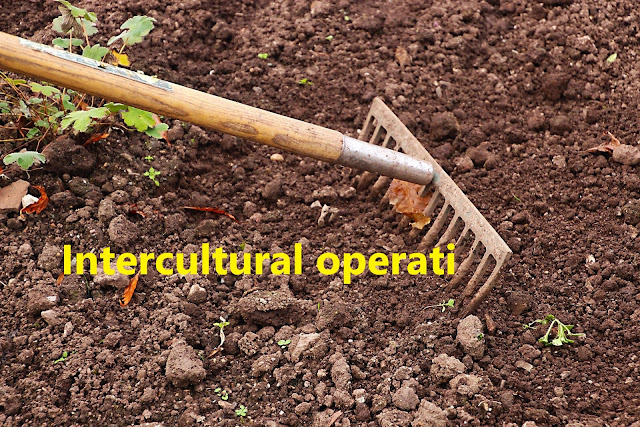Intercultural operation in agriculture
 |
Weeding
Removal of weeds is known as weeding. Weed is a plant grown where it is not desired
Objectives
i. To reduce the competition of weeds to crop plants for light, space, water and nutrients.
ii. To get expected output (yield) from crop cultivation.
iii. Weeding in dry condition fulfills the objective of natural mulching.
Mulching
Mulching is a method of conserving soil moisture. It is a very important intercultural operation for rabi and rainfed crops. It is done by making a covering on the soil surface which actually reduces the evaporation of soil water. Mulches are the materials used for mulching.
Objectives
i. To conserve soil moisture.
ii. ii. To reduce excess evaporation loss of soil moisture.
iii. iii. To ensure economic use of irrigation water.
Advantages
i. It keeps the soil moist during the dry season.
ii. It suppresses weed growth and population.
iii. Keeps the soil cool during dry and hot season.
iv. Use of mulches like water hyacinth or straw adds significant amount of organic matter to the soil after decomposition.
v. Natural mulching aerates the soil which helps better respiration of plant roots.
vi. Mulching becomes essential for some crops to prevent contact of product with soil as for example fruits of straw berry plants if come in direct contact with the soil then the fruits will rot. So, mulching becomes essential for strawberry.
Types of mulch
i. Natural mulch (water hyacinth, straw, leaves etc.)
ii. ii. Artificial mulch (polythene, paper etc.)
Types of mulching
i. Natural mulching
ii. Artificial mulching
Natural mulching
It is a method of breaking the surface of dry soil and generally done by stirring the soil surface with the help of some implements like niri, khurpi etc. Weeding in dry condition with the help of niri or khurpi results in natural mulching. When the soil becomes drier, water vapour moves upward towards the soil surface through capillary tubes and escapes into the atmosphere. Natural mulching breaks the soil crust and thereby, opening of capillary tubes gets broken and blocked which results in prevention of upward movement of water vapour. Hence, upward movement of capillary water is restricted and soil moisture is conserved.
Artificial mulching
This includes application of plant leaves, straw, water hyacinth, polythene, sawdust etc. so as to provide a covering on the surface soil which can check the evaporation of soil moisture. Mulch crops may also be grown to conserve soil moisture in bare ground by their thick and multilayered foliage, trailing habit and sometimes, self-seeding nature, for instance cow pea, Alylosia.
Earthing up
Earthing up consists of lifting up or shifting the soil from the central portion of the space between rows towards the base of plants so as to cover the plant base or certain plant organs grown from below or at the soil surface. Earthing up may be done both under wet and dry conditions of soil.
Objectives
i. To make better root anchorage.
ii. To prevent lodging.
iii. To cover stolons and rhizomes in some crops.
Advantages
i. Earthing up creates ridges and furrows in the crop field which later on serves the purpose of irrigation channel.
ii. Earthing up reduces weed growth and population.
iii. Earthing up closes the spreading tillers in sugarcane which makes the tying of canes easier.
iv. Earthing up increasing the number of tubers in potato and prevents solarization of developing tubers.
v. The initiation of new (late) tillers in rice and sugarcane or rhizomes in taro, turmeric and ginger are restricted. vi. The pegs of groundnut, the stolons and the tubers of potato and the stilt roots of maize are covered with earth.
Thinning
Removal of excess plants after germination from the crop field or seed bed is called thinning. Excess plants in a crop field reduce crop yield due to intra crop competition. As a result there occurs shortage of space, nutrients, light, air and moisture for individual crop plant which ultimately reduce yield. So, if required, excess seedlings are removed leaving the strongest ones.
Gap filling
Several frugivorous and granivorous animals and birds feed on many seeds after they are sown in the field. Moreover, after transplanting many seedlings fail to establish them in the new environment and dies. Then. Gap filling with seeds staggers the period of germination and emergence. As a result, ripening periods extend over time and affect the harvesting which is scheduled once for most crops; and this seriously impairs the quality of produce.
Objectives of thinning and gap filling
The ultimate goal is to ensure the optimum plant population in the crop field. Plant population more than optimum creates competitive condition whereas that less than optimum results in misuse of space, irrigation water and other inputs.
Advantages
Both thinning and gap filling ensures ideal plant population and optimum utilization of sunlight, space, nutrients, moisture and other inputs which ultimately increases yield.